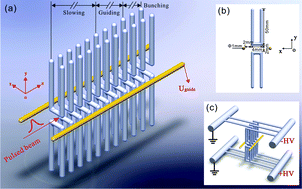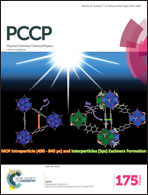Slowing and cooling of heavy or light (even with a tiny electric dipole moment) polar molecules using a novel, versatile electrostatic Stark decelerator†
Abstract
To meet some demands for realizing precise measurements of an electric dipole moment of electron (eEDM) and examining cold collisions or cold chemical physics, we have proposed a novel, versatile electrostatic Stark decelerator with an array of true 3D electric potential wells, which are created by a series of horizontally-oriented, U-shaped electrodes with time-sequence controlling high voltages (±HV) and two guiding electrodes with a constant voltage. We have calculated the 2D electric field distribution, the Stark shifts of the four lowest rotational sub-levels of PbF molecules in the X12Π1/2(v = 0) electronic and vibrational ground states as well as the population in the different rotational levels. We have discussed the 2D longitudinal and transverse phase-space acceptances of PbF molecules in our decelerator. Subsequently, we have simulated the dynamic processes of the decelerated PbF molecules using the 3D Monte-Carlo method, and have found that a supersonic PbF beam with a velocity of 300 m s−1 can be efficiently slowed to about 5 m s−1, which will greatly enhance the sensitivities to research a parity violation and measure an eEDM. In addition, we have investigated the dependences of the longitudinal velocity spread, longitudinal temperature and bunching efficiency on both the number of guiding stages and high voltages, and found that after bunching, a cold packet of PbF molecules in the J = 7/2, MΩ = −7/4 state with a longitudinal velocity spread of 0.69 m s−1 (corresponding to a longitudinal temperature of 2.35 mK) will be produced by our high-efficient decelerator, which will generate a high energy-resolution molecular beam for studying cold collision physics. Finally, our novel decelerator can also be used to efficiently slow NO molecules with a tiny electric dipole moment (EDM) of 0.16 D from 315 m s−1 to 28 m s−1. It is clear that our proposed new decelerator has a good slowing performance and experimental feasibility as well as wide applications in the field of precise measurements and cold molecule physics.


 Please wait while we load your content...
Please wait while we load your content...